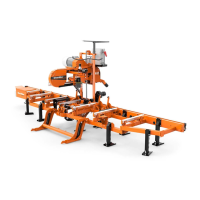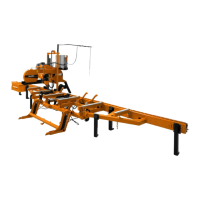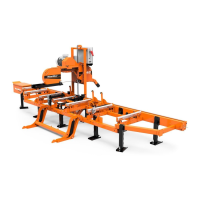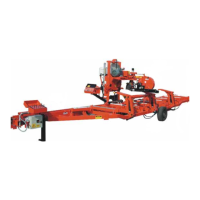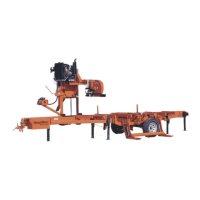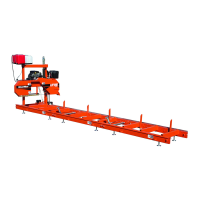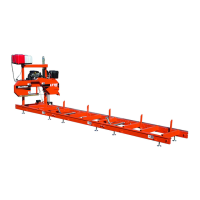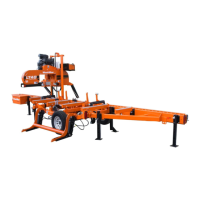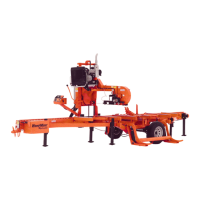
Do you have a question about the Wood-mizer LT40 AH Series and is the answer not in the manual?
| Brand | Wood-mizer |
|---|---|
| Model | LT40 AH Series |
| Category | Saw |
| Language | English |
Procedures for safely handling bandsaw blades, including warnings.
Instructions for setting up the sawmill securely and safely on various grounds.
Guidelines and safety precautions for operating the Wood-Mizer sawmill.
Procedures for routine maintenance, including securing parts and lubrication.
Safety precautions and checks required before towing the sawmill.
Specifications for various belts used in the LT40 Series AH sawmill.
Recommendations for choosing Wood-Mizer TRU•SHARP™ blades based on wood type.
Log size capacities for LT40 Series AH and LT40 Wide sawmills.
Details on power options and motor specifications for the LT40 Series AH.
Average noise level data for the LT40AE15AH and LT40AE25AH models.
Table listing the overall dimensions and weights of LT40 Series AH sawmills.
Load capacity specifications for power feed and up/down chains.
Specifications for the sawmill's hydraulic system, including pump and pressure rating.
Technical details for dust extractors used with the sawmill.
Diagram showing the major components of the Wood-Mizer LT40 Series AH.
Conditions and requirements for setting up the sawmill before operation.
Steps for setting up a stationary sawmill on firm footing and leveling it.
Installation and setup procedures for sawmills equipped with a cable guide system.
Instructions for setting up a portable sawmill, including outrigger adjustments.
Identification and function of control panel components for sawmill operation.
Procedure for cleaning and installing the middle track cover.
Step-by-step guide for safely replacing the bandsaw blade.
Instructions on how to properly tension the sawmill blade using the tension gauge.
Procedure for tracking the blade on the blade wheels for optimal cutting.
Safety warnings and procedures for starting the sawmill motor.
Operation of the automatic board return system and related safety warnings.
Explanation of how hydraulic control levers operate the sawmill functions.
Detailed steps for loading, turning, and clamping logs onto the sawmill bed.
How to use the up/down switch to adjust the cutting head height.
How to adjust and operate the blade guide arm for cutting.
Operation of the optional clutch/brake system for engaging/disengaging the blade.
Instructions for operating the power feed system for carriage movement.
Step-by-step guide for normal operation of cutting logs with the sawmill.
Procedure for edging boards on the Wood-Mizer sawmill.
How to use the blade height scale for accurate lumber thickness.
Operation of the water lube system to keep the blade clean.
Instructions for preparing the sawmill for safe and convenient transportation.
Estimated life expectancy of common replacement parts for planning.
Procedures for checking and maintaining blade guide rollers and blocks.
Instructions for removing sawdust from various parts of the sawmill.
Maintenance of carriage tracks, wipers, and scrapers for smooth operation.
Cleaning and lubrication of vertical mast rails.
Lubrication procedures for drum switch contacts in the control panel.
Various maintenance tasks including lubrication, decal checks, and alignment.
Lubrication and fluid addition for the blade tensioner system.
Checking and replacing blade wheel belts for optimal performance.
Procedures for checking and adjusting drive belt tension.
Hydraulic fluid level checks, replacement, and temperature considerations.
Refilling fluid in the drive-side cylinder bearing housing.
Greasing the up/down gear reducer shaft bearing and adjusting chain tension.
Adjusting the power feed belt and chain tension for proper operation.
Procedures for inspecting E-STOP button, control circuits, and safety switches.
Common sawing issues and their solutions, like dull blades or wavy cuts.
Diagnosing and resolving electrical issues with motors, switches, and wiring.
Troubleshooting jerky, sluggish, or overheating power feed systems.
Identifying and fixing issues with hydraulic handles, pumps, and fluid leaks.
Steps for aligning motor and drive pulleys for optimal belt performance.
Testing the power feed variable speed switch for proper response.
Preliminary test to distinguish between mechanical and electrical power feed issues.
Performing mechanical checks on the power feed system components.
Routine and complete alignment procedures to ensure accurate sawing.
Instructions for setting up the sawmill frame on firm, level ground.
Steps for installing the blade and aligning it on the blade wheels.
Adjusting the nylon pads on the saw head slide for proper contact.
Adjusting lower track rollers for square cuts and accurate board dimensions.
Procedures to adjust bed rails to ensure they are parallel to the blade.
Aligning the blade guide arm assemblies for straight cuts.
Achieving proper blade deflection using the blade guides.
Adjusting the vertical tilt of the blade guide for accurate measurements.
Setting the correct spacing between blade guides and the blade.
Adjusting the horizontal tilt of the blade guide rollers.
Adjusting the gap between the blade guide disc and the blade.
Ensuring side supports are square to the bed for lumber accuracy.
Adjusting side supports to be perpendicular to the bed rails.
Adjusting clamp stops and stop bolts for precise positioning.
Compensating for saw head drop when cutting wide logs or cants.
Calibrating the blade height scale for true distance measurement.
Procedures for inspecting and maintaining the motor brake system.
